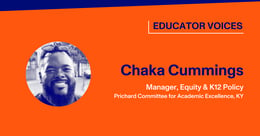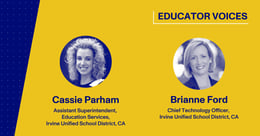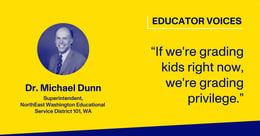
Teachers share the tangible—and intangible—rewards of the job
Teaching is many things. For instance, it can be a calling, a craft, a career, and a challenge. But for many educators, the rewards speak for themselves.
We spoke with dedicated teachers from across the country about what keeps them energized.
[READ: “Teachers talk: The best strategies to drive student motivation”]
Though these educators teach many different subjects and grade levels, they shared a lot of common ground when it came to their appreciation for thoughtful gifts, lightbulb moments, long-term student growth, and grateful feedback from their scholars.
Tokens of appreciation
When the topic of how teachers like to be thanked came up, Clay Hale of East Side Union High School District in California did not demure.
“Any type of event … where there’s free food, travel involved—cookies—are a great way of thanking a teacher for their work,” laughed Hale.
Who doesn’t like a sweet treat or a little time to disconnect and unwind? Sometimes these kinds of special gifts can help teachers feel seen, valued, and appreciated.
Jamie Marie Wilson of Texas’ Mesquite Independent School District described how just such a gift—with a few extra personal touches—brought her to tears.
“One of my students made me cry on their first day of summer this year,” said Wilson. “She showed up … with a cup with my name on it, and crowns, with a lid—because I spill, she knows me!—and a Starbucks gift card.”
From Georgia’s Gwinnett County School District, Whitney Van Lierop described how candy, coupled with personalized notes from her students, helped her see how important the relationships she cultivated in her classroom were.
“They filled a jar with M&M’s, and then they wrote out in cursive what each color represented, and it was some quality about me that they had appreciated,” said Van Lierop.
Everyday magic: Finding inspiration in the lightbulb moment
It should come as no surprise that for many teachers, supporting their students is the highlight of their work. When David Long of Boston Public Schools was asked what the best part of his job was, there was no hesitation.
“Working with the kids,” said Long, definitively.
One particularly exciting aspect of working directly with students is the fabled “lightbulb moment”—the instant when a new concept suddenly transforms from inscrutable to understood.
“Every kid has that a-ha moment at some point—when they’re frustrated, and they don’t get it, and they’re working on it, and all of a sudden they’re like, ‘I did it! I got it!’” said Lissa Teston of Harnett County Schools in North Carolina. “That’s the best part of my job. That’s what I’m there for.”
Melinda Evans of South Tippah School District in Mississippi agrees.
“When I see the excitement when a child has struggled, and they’re like, ‘Oh my gosh, I got it!’—that is so rewarding to me,” said Evans. “It’s priceless.”
“Especially if you've been working with them for so long on a certain concept, and then they can finally get it,” added Ashley Bebow of Michigan’s Hemlock Public School District.
[READ: “Building confidence: Ashley Bebow on the impact of Paper™ in her classroom”]
However, as Dr. Victoria Lindemann from Clark County School District in Nevada noted, teachers also watch their students go through bigger life transitions that can sometimes eclipse the immediate confidence boosters they get from a-ha moments.
“Look at eighth grade, where they’re on the precipice of their next leg of the journey,” said Lindemann. “In 12th grade, they’re going into the next step—into adulting—and so the same fears are showing up.”
Fortunately, teachers also told us they derive a lot of satisfaction from preparing students for long-term success, no matter where their journeys lead.
Nurturing learners to pursue a bright future
Career educators know that some of the most meaningful expressions of gratitude they’ll receive may come years down the road. That’s true for Alyssa Kotovsky, who discussed how the first-year high school students she teaches in Florida’s Hillsborough County Public Schools sometimes come back to share their gratitude once they’re seniors.
“By the time they're a senior, and they come by, [they say] ‘Thank you so much for preparing me!’” said Kotovsky. “It’s not just English that I’m helping them with. It’s other things as well.”
At each grade level, teachers feel they have a unique role to play in helping elicit long-term growth. As Nicole Bobby of Pine Bush Central School District in New York put it, it’s all about planting seeds.
“I don’t always see kids grow and bloom in seventh grade, but then I see them at their high school graduation,” said Bobby. “It’s nice being able to plant those seeds and see them bloom down the line.”
Of course, updates from colleagues can also help teachers keep tabs on their students over the years.
“When I hear about the success, when I hear that students feel empowered, to me, that’s the most meaningful thank-you I could ever imagine,” said Rebecca Gaynon of California’s South San Francisco Unified School District. “Because then I trust that what I’m doing is working.”
[READ: “A new approach to academic support brings equity to a diverse school district”]
Other educators get to see their students’ progress firsthand and in real time. That’s one reason Boston Public Schools’ Molly McDonlad is grateful to work in a school that serves students all the way from seventh through 12th grade. It’s also a big part of why she loves being in the field of education to begin with.
“I think people who aren’t in that world probably can’t even imagine what it’s like,” said McDonald. “There’s that full gift of knowing people when they’re quite young and seeing them turn into adults.”
In addition to academic growth, teachers also told us they love to see learners find their voice and develop crucial life skills.
“That’s what motivates me: when I see that there is success and there is hope and they feel confident,” said Lizzette Leborgne, who teaches in Florida’s School District of Palm Beach County. “Everyone has a story to tell.”
[READ: “Key classroom extension: How one ELA teacher uses Paper’s Review Center”]
Positive feedback, straight from the source
When we talked to teachers, we discovered that one of the simplest forms of recognition they typically receive—direct feedback and a genuine, heartfelt thank-you straight from their students—also turned out to be the most profound. In fact, this was especially true when praise came from seemingly unlikely sources.
“The ones that get me are always the kids I don’t expect, who I thought hated my class all year,” said Jennifer Welch of Clark County School District. “Then they write, ‘I always hated English until your class!’”
In some instances, these expressions of gratitude can be a complete surprise. That’s how Lacy Snelling, a teacher from Washoe County School District in Nevada, described one such experience.
“I had a student … who never expressed, during the school year, any sort of appreciation—and actually seemed to not enjoy English,” said Snelling.
As the year drew to a close, this learner presented Snelling with a touching box of family mementos and a note about how much she liked the teacher’s class.
[READ: “5 questions with Nevada superintendent Dr. Susan Enfield”]
The educators we spoke to also appreciated when their students’ family members showed their gratitude as well.
“I love when I get notes from my kids or parents,” said Alexandra Pantastico of the J.O. Combs Unified School District. “It’s nice whenever parents recognize you.”
[READ: “To advance career and college readiness, Arizona’s J.O. Combs USD adopts 24/7 educational support”]
We can’t say it enough
To all the teachers who work hard every day to ensure their students have everything they need to build confidence, gain knowledge, and get ready for what’s ahead, thank you.
Want to find out how Paper supports teachers and students in the Magnolia State? Check out our case study, “State test prep gets a boost in Mississippi district with an Educational Support System.”






